
Petra, Steps of Jesus, Paul & John: 22 Day Tour Package 2026
Many departure dates year round.
Book Your Tour Online Request a Quote

Wholesale Tour Packages Since 1987 - Call Us Toll Free: 800.322.0788

Many departure dates year round.
| Dates | Land Only No Transfers |
Early Reservation Discount (8 Mo. Adv.) |
|---|---|---|
| 2026 (Prices Include Cruise Tours) | ||
| April 4-25 (Wait-list only) May 2-23 (Wait-list only) |
$6,749 | $6,609 |
| May 23-June 13 July 4-25 August 8-29 August 22-September 12 September 19-October 10 October 3-24 |
$6,899 | $6,759 |
Single Supplement: Year-round 2026: $2,525* (inside cabin), $2,725 (outside cabin) *SINGLE CRUISE CABINS ARE LIMITED AND SUBJECT TO AVAILABILITY. A $200 DISCOUNT IS AVAILABLE TO SINGLE PASSENGERS WHO ARE WILLING TO SHARE A CRUISE CABIN. |
||
Click here for "Frequently Asked Questions"
Category Prices - Cruise Ship Info
Shore Excursion Info - Click Here
Shore Excursion Info (for tours altered by daylight savings) - Click Here
Price Includes: Land Portion - Amman Airport Greet & Assist Service (eliminates $60 visa fee normally required on arrival), first class (4 Star) lodging, breakfast and dinner daily, modern transportation, sightseeing as listed.
Cruise Portion - Inside cabin (category D), 2 port tours (Patmos & Crete), onboard gratuities, non-alcoholic beverage package, all meals.
Please Note: Jordan, Israel, Turkey, and Greece gratuities will be paid in advance ($280 per person will be added to your final invoice for gratuities to be paid to driver, guide, and hotel staff while in Jordan, Israel, Turkey, and Greece).
Not Included: Land Portion - travel/cancellation insurance.
Cruise Portion - Port taxes & service charges. ($180 will be added to your final invoice to prepay this cruise
charge). Greek port taxes will be assessed to your onboard account on the ship and vary by port and season (€1 to €20 per port).
Flight Departures - Airfare (including Tel Aviv to Izmir flight), special fares are available nationwide including transfers. (transfers not included unless airfare is purchased from Pilgrim Tours)
Please Note: As of December 23, 2023, US Passport holders are no longer required to obtain a Turkey E-Visa for entry. If traveling from another country, please review entry requirements as Turkey Entry Visas must be completed prior to arrival. Visas can be obtained in advance online using this link: Click Here
Airport transfers are included only when airfare is purchased from Pilgrim Tours. Taxi service is available for those purchasing their airfare elsewhere.
Please Note: Travelers from Visa Exempt countries (which include the United States, Canada, UK, Australia, and many others) visiting and/or traveling through Israel must apply for an ETA (Electronic Travel Authorization) online at Israel ETA-IL Application (https://israel-entry.piba.gov.il/). Once approved, an ETA confirmation will be emailed to you. There is no need to print this confirmation; simply save it on your phone. The cost of the ETA permit is 25 shekels (approximately 7 USD), and it permits stays of up to 90 days. The permit remains valid for up to two years or until your passport expires, whichever occurs first. Failure to meet these entry requirements may result in loss of tour participation and associated penalties.
*Customers traveling to Israel that do not provide their full passport information will incur an additional fee of $160 per person to cover the Israel VAT (value-add tax) on their final invoice.
Deposit Required: A $500 per person US Dollar deposit (which includes a $100 non-refundable service fee) is required to secure a reservation.
Day 1: Departure
Our life-changing journey begins this evening as we board our overnight flight to Jordan.
Day 2: Arrival Jordan
We arrive in the Hashemite Kingdom of Jordan and transfer to our lodging for the evening in Amman. Enjoy dinner, retire to your room and be ready for an early departure in the morning. (D)
Day 3: Jerash, Petra
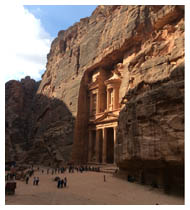
This morning we travel to Jerash, one of the best preserved and most complete provincial Roman cities. Jerash, Gerasa of Roman Times, was one of the cities of the Decapolis, a confederation of 10 Graeco-Roman cities dating from the 1st century BC situated in Jordan, Syria and Israel. Known as the Pompeii of the East for its extraordinary state of preservation, the ruins indicate human occupations at this location for more than 2,500 years. From here, we continue on to our lodging for the evening in Petra. (B, D)
Day 4: Petra
Early this morning we turn southward toward the amazing mountain fortress of Petra, known to be inhabited by the Edomites - the descendants of Esau. Begin the tour with a walk through the "Siq," an immense crack in the Nubian sandstone, to the city of Petra carved out of the rose red rock. The Treasury, El Khazneh, is one of the most elegant remains of antiquity. Beyond El Khazneh we are surrounded on both sides by hundreds of Petra's carved and built structures. Departing Petra, we travel northward on the King's Highway where to the west we view the hills bordering the Dead Sea. This is the area of the hilltop palace/fortress of Machaerus, where John the Baptist was beheaded. We overnight in Amman this evening. (B, D)
Day 5: Mt Nebo, Madaba, Tel Aviv

Our morning tour begins in the town of Madaba, the biblical Medeba, 30 kilometers south of Amman. Madaba is best known for its Byzantine and Umayyad mosaics and at the Greek Orthodox Church of St. George we view the earliest surviving mosaic map of the Holy land. Mt. Nebo, believed to be the site of the tomb of Moses, commands a spectacular view across the Jordan Valley and the Dead Sea. Study the panorama as we read the scripture of God showing Moses the "Promised Land" before He brought him home to heaven. As we travel west toward the Allenby Bridge, we view to the north the Plains of Moab, the area where the tribes of Israel camped before crossing the Jordan and picture the place where Jesus was baptized. Crossing back into Israel, we drive to Tel Aviv area with the remainder of the afternoon free. You may wish to take a devotional time with the sunset over the “Great Sea,” a time of prayer and thanks for the special blessings ahead, a prayer for the people of this land, and then enjoy a good night’s rest. (B, D)
Day 6: Caesarea, Megiddo & Nazareth
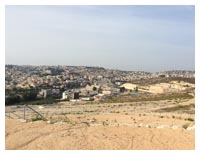
After breakfast, we travel by private motor coach along the coast of the Mediterranean Sea to Caesarea, where Gentiles first heard the Good News from Peter and were baptized. We’ll see the Roman Amphitheatre, hippodrome, a film on history and the remains of this famous port city, an aqueduct, and then journey through the Mt. Carmel range, where Elijah challenged King Ahab and the prophets of Baal. Next we travel through the Jezreel Valley to Megiddo, the Armageddon battlefield, where archaeologists have unearthed 20 levels of civilization. We drive through the area of Cana and Nazareth, the boyhood home of Jesus, where we visit the Nazareth Village, a wonderful recreation of Biblical times with costumed guides. We will have dinner and overnight lodging for the next three nights along the Sea of Galilee.
Day 7: Dan, Caesarea Philippi, Jesus Boat, Sea of Galilee Boat Ride, Magdala
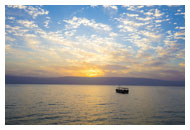
Following breakfast, our morning travels take us to two valuable northern sites. Dan is where the children of Israel fell to the depths of alternative sacrifice and Caesarea Philippi, the site of Peter’s confession and pagan worship. We pass the possible site of the multiplication of loaves and fishes in Bethsaida and the Mount of the Beatitudes. Returning to Galilee for a St. Peter’s fish lunch (other selections available), we then visit the ancient fisherman boat followed by a relaxing cruise on the Sea of Galilee. A brief scripture reading and devotional on board brings to life the experiences of Jesus and the fishermen disciples. We conclude our day with a visit to Magdala, hometown of Mary Magdalene. The recent excavation of the first century synagogue and well-preserved village makes Magdala one of the most interesting Biblical sites in Israel.
Day 8: Capernaum, Corazin, Mt. Arbel, Jordan River Baptism Site

Today we visit the Biblical towns of Capernaum and Corazin. Capernaum is located along the Sea of Galilee and was the hometown of Peter. It is likely where Jesus and the disciples lived during much of His ministry while in Galilee. Next, we visit Corazin which offers another example of a Jewish synagogue and a replica of the “Seat of Moses” which was carved out of the local basalt block and from which the scribes and Pharisees would have read the Torah. We enjoy a bird’s eye view of the Galilee region atop Mt. Arbel. Mt. Arbel could likely be the location that Jesus would get away from the crowds to take time in prayer with His heavenly Father. Here our guide will point out the various towns listed in scripture during the time of Jesus. We conclude our day with an opportunity to be baptized at the Jordan River Baptismal Site.
Day 9: Beit Shean, Bethany Beyond Jordan, Abraham's Tent, Mt. of Olives & Garden of Gethsemane

We travel southward this morning to Beit-Shean/Scythopolis, the most magnificent archeological site in Israel, located at the strategic juncture of the Jezreel and Jordan valleys. Like Jericho, it has been almost continuously occupied throughout history. After defeating Saul and his sons on Mt. Gilboa, the Philistines hanged their bodies on the walls of Beit-Shean. During the time of Jesus, Scythopolis was one of the chief cities of the Decapolis - a league of ten cities sharing Greek culture and government. Following the fertile Jordan Valley southward, your guide will point out the agricultural restoration of the “Land of Milk and Honey” and Israel’s intricate irrigation development. We pass ancient Jericho and view from a distance this city famed as the oldest in the world. To the east of Jericho along the Jordan River Valley (Queser El Yehud) is the Israeli side of Bethany Beyond the Jordan. In this area Jesus was baptized by John the Baptist; Elijah and Elisha crossed the Jordan; and the children of Israel, led by Joshua, entered the Promised Land. This afternoon we will take part in the Genesis Land/Dinner in Abraham's Tent, where we enjoy a trip back in time to relive life in the time of the Patriarchs, complete with costume, dramatic presentation, camel ride and authentic food. Arriving in Jerusalem we’ll enjoy a beautiful view of the Old City atop the Mt. of Olives and then the Garden of Gethsemane. How many have wished to be whisked back in time to get a glimpse of our Lord or hear His voice if only for a moment? To walk between the ancient olive trees, read the scriptures of Jesus' prayer and take time for personal reflection is important here. We will have dinner and overnight lodging for the next four nights in Jerusalem.
Day 10: Masada, Ein Gedi, Dead Sea Scrolls, Dead Sea Swim
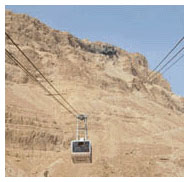
Our day begins with a cable car ride to the mountain top fortress of Masada. Here our guide will treat us to the history of the famous zealot stand. Afterwards we proceed to Ein Gedi, "Spring of the Goat," an oasis on the western shore of the Dead Sea. Because of its warm climate and abundant supply of water, the site developed a reputation for its fragrant plants and date palm groves. This is where King David hid from Saul and where God defeated the enemies of the Israelites by praise and worship led by King Jehoshaphat. Next, we visit the Qumran Caves where the Dead Sea Scrolls were discovered. This afternoon we have an opportunity to enjoy a relaxing float in the Dead Sea.
Day 11: Jesus’ Steps, Western Walls, Southern Steps, Way of Suffering, Garden Tomb
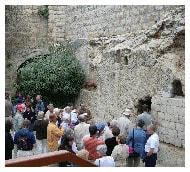
Today we walk where Jesus walked, beginning the day with a visit to the Wailing Wall and then the fascinating Rabbinical Tunnels leading us through the Second Temple era. The tunnel and exhibit give a clear understanding of the amazing construction of the Temple Mount, giant stones, water supply and Roman street where our Lord was led to judgment. Before exiting the tunnel, we see the immense cornerstone rejected by the builders. Next, we visit the Southern Wall Excavations. This southern side of The Temple was the main entrance for the common folk, whereas the Priests and Levites had their own entrance from the higher eastern side. Parts of the giant stairs, which led to the Temple Mount from the courtyard have been unearthed along with the purification pools. From here Jesus entered the Temple Mount and drove out the vendors and money exchangers who were exploiting the people. It is also likely that this is the place where Peter stood and preached and where thousands were saved and baptized on the Day of Pentecost. This afternoon we move on to the Judgment Hall of Pilate, hear of those who conspired against Him and are reminded of His brutal beating and humiliation. From here we will also be able to see the Pool of Bethesda, Stephen's Gate, and St. Anne’s Church. While walking along the Via Dolorosa, we are reminded of His way of suffering along with a visit to the Church of the Holy Sepulcher. Our guide will explain the differing opinions on the route where Christ was led. (The actual place of crucifixion and burial is a very interesting study!) The climax of the day is the area of Golgotha (place of the skull) and the Garden Tomb, where we celebrate the resurrection with communion and a time of praise.
Day 12: Israel Museum, Friends of Zion Museum, Bethlehem
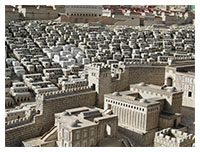
An interesting and educational time awaits us today at the Israeli Museum. Walk through collections of century’s old Israeli artifacts including the Dead Sea Scrolls, and then a guided walk through an accurately detailed model of Biblical Jerusalem. This model will help put into perspective all that you have seen over the previous days’ touring. We then visit the Friends of Zion Museum to learn of the 19th and 20th century heroes of the Jewish people. We spend the remainder of the day surrounding the birth of Christ with a visit to Bethlehem. This evening we enjoy a special lecture by a local believer prior to dinner, giving us a perspective of Messianic life in Israel.
Day 13: Arrive Izmir
We fly to Izmir and transfer to our hotel in the lovely port city of Kusadasi, Turkey for the next two evenings. The remainder of your day is free to walk along the scenic waterfront, sightsee on your own and enjoy your hotel facilities. (B, D)
Day 14: Ephesus

We travel to the nearby town of Selcuk for a visit of ancient Ephesus. Ephesus was once a thriving port town of 250,000 people. Today you can still see the spectacular excavations of the major streets in this ancient city. We view the Library, Agora, theatre, colorful mosaics in the aristocratic Terrace Houses, and a panoramic outlook of the surrounding ancient port area (including a wealth of church history and cultural insight). Then we continue with a visit to the Basilica Church of St. John, which houses an immersion baptismal and is believed to be resting place of John. From here we have an excellent overview of the Ephesus harbor, the Mosque of Jesus, and see the site of the Temple of Artemis, which is listed as one of the Seven Wonders of the Ancient World. (B, D)
Day 15: Isle of Patmos
This morning, we embark our cruise ship and sail for a visit to the beautiful Isle of Patmos, which is under statutory protection as a historic monument. Here we have a tour to see the fortified monastery of St. John and the cave claimed to be where John received the Revelation. Back on the ship, enjoy dinner before settling in to your cabin for the night. (B, D)
Day 16: Crete & Beautiful Santorini
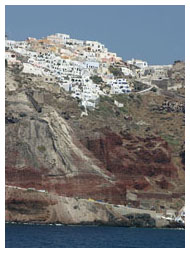
Crete is the largest and the most rugged of the Greek islands. Take a tour to Heraklion and the fantastic ruins of the Palace of Knossos. Discovered in 1899 and partially reconstructed, the elaborate Palace is believed to be the mythical Labyrinth of King Minos and the seat of ancient Minoan culture. This afternoon visit the island of Santorini which is perhaps the most breathtaking of all the Greek Islands. You may choose to take an optional panoramic bus tour viewing some of the most spectacular scenery of the Aegean. Travel through countless villages and settlements with delicate architecture and beauties eventually arriving in Oia. During your time in Oia, visit the many narrow streets, open-air cafes and glittering boutiques. Upon returning to the ship, we view the lace-like caldera, the little islands of Thirasia, Palea, & Nea Kameni. We arrive at the ship for dinner and evening entertainment. (B, D)
Day 17: Disembark Cruise – Ancient Corinth & Cenchreae
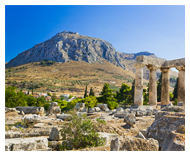
We disembark the cruise this morning and travel west with a rest stop and photos at the Corinth Canal. Next, we visit ancient Corinth, the city that inspired many of Paul's most familiar letters and is a highlight for the New Testament scholar. See the Archaeological Museum, the Market Place, the Bema, and the Temples. To enjoy a devotional in the midst of the ruins of the church of Corinth and see the pillars, steps, and public worship place where Paul preached will enhance your understanding and love for the Bible. The ruins of this important cultural center are fascinating as we walk along the stone path that the Apostle Paul walked. The engineering skill and intellect of these people are evident in the water systems that still flow from ancient to modern day. Our guide will be sure to show you the room dedicated to the medical care of that period. We travel on to the top of the nearby Acropolis where our guide will speak on the worship practices and point out the bird’s eye view of what was a bustling city of around 800,000 during Paul’s stay. Another important stop is a visit to Diolkos where we view the paved trackway which enabled boats to be moved overland across the Isthmus of Corinth and served as a life line for Corinth. This shortcut allowed ancient vessels to avoid the long and dangerous circumnavigation of the Peloponnese peninsula. Before returning to Athens, we will visit Cenchreae, the ancient port region of Corinth. Acts 18:18 states the Apostle Paul stopped at Cenchreae during his second missionary journey, where he had his hair cut to fulfill a vow. (B, D)
Day 18: Athens
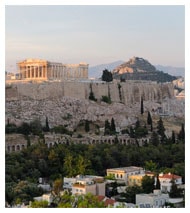
Following breakfast this morning we tour Athens, the foundation of democracy. We visit the Acropolis, the Parthenon, and Erectheum before viewing Athens atop Mars Hill where Paul stood and preached the truth to the Gentile nation. From atop Mars Hill we view the Agora below, the ancient marketplace and center of Athenian public life. Additional sites viewed during our panoramic bus tour are, the House of Parliament, the Tomb of the Unknown Soldier, Olympic Stadium, and Presidential Palace. An option later this afternoon is a visit to the famous Plaka with a multitude of shops and cafes. (B, D)
Day 19: Meteora Monastery
From Athens, our tour travels northward past Thermopylae where we learn of the famous Spartan battle of 300. We continue through the mountains to Meteroa. Here we see the world famous Byzantine monasteries that are perched precariously on summits of gray rock pinnacles of varied and beautiful shapes. Their history goes back to the 14th century when the monks sought refuge in the cliffside caves then fled higher to build the original wooden shelters, later transformed into monasteries. Our lodging this evening will be in Meteora. (B, D)
Day 20: Vergina, Berea, Thessalonica
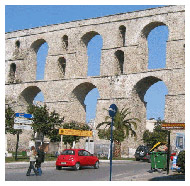
Traveling north this morning, our first stop will be a visit to King Phillip's (Alexander's father) tomb in Vergina, one of the most outstanding finds in all of Greece. We then make the short trip to nearby Berea to view the synagogue wher Paul preached. We stop at the Bema surrounded by mosaics of Paul and the plaque of scripture regarding the "more noble" church. The New Testament books of I & II Thessalonians will come alive to us today as we arrive in the delightful harbor city of Thessalonica. En route to the hotel we will view the old city ramparts; the newly excavated Forum, St. George Church, an ancient Roman monument which was transformed into a church and the Galerius Arch which rises over the famous Via Egnatia. We spend two nights here. (B, D)
Day 21: Thessalonica/Philippi/Kavala
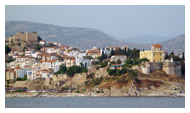
We begin the day by following the massive battlement Byzantine wall to the citadel for a panoramic view of the city. Next, we will visit Philippi and Kavala. Kavala is Greece's prettiest mainland port with a most elegant harbor. Paul landed here with his disciples, Timothy and Silas. Luke, the Evangelist, also came here from Troas. This ancient city of Neapolis was later renamed Christoupolis because it was the first European city to accept Christianity. Imagine walking on the same sod as these men of the Bible! We will see the Roman Aqueduct and the ruins of the Acropolis in this beautifully located city, known since the 5th century as Kavala. Continue on to Philippi where Paul preached his first evangelical sermon and baptized the first Christians on European soil. We will view the baptismal site where Lydia surrendered her life to Christ and visit a crypt dating from the Roman period that is thought to have served as a prison for Paul. See the famous Acropolis, the Market Place, Basilica, and the Theatre. We return to Thessalonica and visit St. Demetrius Basilica, dedicated to a distinguished member of the Roman army and a martyred Christian convert, before returning to the hotel for our final night. (B, D)
Day 22: Home
A very early morning departure for the Thessaloniki Airport for our flight homeward will allow for arrival home by early afternoon.
*The tour itinerary is subject to change or be slightly modified in order to best meet the interests of the group.
Important Note: Although the itinerary above obviously emphasizes the spiritual aspect of this marvelous country, our guides are also experts in and passionate about the miracle of the return of the Jews and the restoration of the state of Israel. This fact, along with many modern day topics (military, politics, education, and other cultural aspects), will be woven into the commentary in order to give you well rounded information.